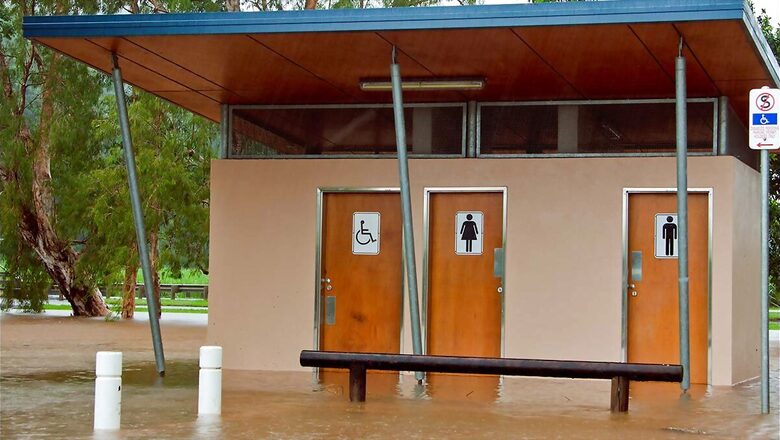
views
India, a land of diverse climates and breathtaking beauty, is no stranger to the challenges posed by nature’s whims. From the scorching heat of summers to the bone-chilling cold of winters, its people have learned to adapt and thrive in the face of adversity. But there is one season that stands out, that tests the resilience and spirit of the nation like no other—the monsoon.
As the dark clouds gather and the heavens open up, the monsoon brings with it a torrent of rain, transforming the arid landscapes into lush green paradises. But amidst the beauty lies a question that affects the very fabric of the agricultural sector, and hence, the nation: how much rain will come? Will we get enough to nourish the crops, but not so much as to drown them? Will we have enough to replenish our reservoirs, but not so much as to flood them? It’s a delicate balance.
If not for this delicate balance, the monsoon season can have a dark side—a side that threatens the very well-being of millions, particularly those in rural areas and crowded slums. There is the headline grabbing physical destruction floods bring; and the less flashy, but no less grave threat the monsoon poses to the sanitation and hygiene of the affected communities. In rural areas and slums, where access to clean water and proper sanitation facilities is already a challenge, the monsoon turns up the volume, and makes it that much harder to keep these communities safe.
The Problem of Monsoon and Clean Toilets
Clean toilets are central to any strategy for preventing disease amongst our populations, and keeping them healthy: It’s crucial to have access to proper toilets to maintain good hygiene, avoid water pollution, and reduce the risk of illnesses spread through water. However, during the monsoon season, when heavy rains cause flooding and waterlogging, regular toilets can become unusable, creating a sanitation crisis.
During the monsoon season, the heavy rain can cause a number of problems for toilets. Floodwaters can enter regular toilets and foul them with debris, sewage, and other pollutants. The excess water can cause toilets to overflow and get clogged, making them unusable. Additionally, the stagnant water left behind can become a breeding ground for mosquitoes that carry diseases, which worsens the public health situation.
The health risks associated with poor sanitation during monsoons are significant. Contaminated water and inadequate sanitation facilities contribute to the spread of diseases like cholera, typhoid, and diarrhoeal infections. The lack of proper sanitation infrastructure also hinders waste management and disposal, leading to the accumulation of waste and the release of harmful substances into the environment. This poses a threat to both human health and the ecosystem, with the potential for water pollution (downstream) and the contamination of agricultural lands.
Monsoon-proof toilets offer a solution to these problems. They are designed to be resistant to flooding, ensuring that they remain functional even during heavy rainfall.
Designing Monsoon-Proof Toilets
Monsoon-proof toilets are specifically designed and constructed to withstand the challenges posed by heavy rainfall. These toilets incorporate various features and techniques to maintain their cleanliness and functionality even during monsoons. Let’s be clear – the monsoons are formidable. We can’t design toilets that are 100% monsoon proof, just as we can’t design monsoon proof cities, stadiums, public transport or any other public utility, but we can improve our designs that better mitigate the challenges we face during the monsoon.
One of the key solutions is the use of raised platforms or stilts to elevate the toilets above the ground level. By raising the toilets, they are better protected from flooding and waterlogging. This simple elevation prevents water from entering the toilet area, allowing for the facilities to remain usable even when homes or businesses near them are struggling with waterlogging. The raised platforms also help in maintaining a dry and hygienic environment within the toilets.
Installing drainage systems or soak pits is another important aspect of monsoon-proof toilets. These systems are designed to divert excess water away from the toilets, preventing overflowing or clogging. The drainage systems can be connected to the existing sewage or drainage network, ensuring that the water is safely and efficiently channelled away from the toilet area. Similarly, soak pits are excavated areas filled with stones or gravel that absorb and disperse the excess water, preventing waterlogging and maintaining the functionality of the toilets.
To make the toilets resistant to water damage and corrosion, durable materials such as concrete, bricks, or tiles are used in their construction. These materials are specifically chosen for their ability to withstand prolonged exposure to moisture and prevent structural degradation. The use of sturdy construction materials ensures that the toilets remain intact and functional even during heavy rains.
Applying waterproof coatings or paints to the walls and floors of the toilets is another important measure in making them monsoon-proof. These coatings create a protective barrier that prevents leakage or seepage of water. By sealing the surfaces, they minimise the risk of water damage and maintain the integrity of the toilets. Waterproof coatings also facilitate easier cleaning and maintenance, helping attendants in ensuring that the toilets remain hygienic and free from water-related issues.
Proper ventilation is crucial in monsoon-proof toilets to improve air circulation, reduce humidity, and eliminate odours. Installing ventilation pipes or fans helps in removing stale air and excess moisture, creating a more comfortable and hygienic environment within the toilets. Adequate ventilation also helps prevent the growth of mould and mildew, which can thrive in humid conditions.
In addition to ventilation, adequate lighting is necessary in monsoon-proof toilets. Well-lit toilets deter insects and rodents from infesting the facilities. By maintaining proper lighting, the risk of infestation is minimised, ensuring a clean and safe environment for toilet users.
Education and training play a vital role in ensuring the proper maintenance and safe usage of monsoon-proof toilets. Users and caretakers should be educated about the importance of regular cleaning, waste disposal practices, and the significance of maintaining the functionality of the toilets. Training programs can be conducted to teach individuals how to identify and address minor issues, enabling them to take proactive measures to ensure the longevity and usability of the toilets.
Collaborative Efforts for Monsoon-Proof Toilets
The development and implementation of monsoon-proof toilets require the collaboration and involvement of government, corporations and non-governmental organisations (NGOs). In India, the Swachh Bharat Mission, where these three behemoths came together, resulted in the construction of 10.9 crore toilets, successfully providing toilets for every Indian.
There are several examples of successful monsoon-proof toilet projects, sponsored or managed by the government. In Bihar, for example, the government has launched a programme to build flood-resistant toilets in areas that were affected by the 2018 floods. These toilets are designed with elevated platforms and sealed pits so that they remain functional even during heavy rainfall.
Corporations in India have also taken up the mantle: Harpic, a leading brand in toilet cleaning and sanitation, has played a vital role in promoting clean toilets, including during the monsoon season. The brand is committed to improving sanitation globally and advocates for everyone to have access to clean and functional. Harpic offers a range of products specifically formulated to effectively clean and disinfect toilets, maintaining cleanliness and hygiene standards even in adverse weather conditions. These products are designed to tackle stains, odours and germs, creating a hygienic environment for toilet users.
Additionally, Harpic has initiated campaigns and partnerships aimed at promoting monsoon-proof toilets. By collaborating with local governments, NGOs, and communities, Harpic raises awareness about the importance of monsoon-proof toilets and the benefits they offer during heavy rainfall.
One notable initiative addressing this issue is Mission Swachhta aur Paani, a campaign launched by News18 and Harpic with the aim of improving toilet sanitation in India. This initiative recognises the importance of toilets beyond a simple functional space. In India, the health of our communities, particularly in tightly packed cities, rests on our ability to create and maintain hygienic toilets for everyone. When our toilets don’t work, our communities pay the price.
Mission Swachhta aur Paani is focused on promoting the cause of monsoon-proof toilets and other measures communities and families can undertake to stay healthy; especially in areas prone to heavy rainfall. By spreading awareness about innovative designs and technologies, Mission Swachhta aur Paani strives to ensure that toilet sanitation facilities remain accessible and functional throughout the monsoon season.
Conclusion
Access to clean and safe toilets is a basic right. For India, with it’s long monsoon season, that translates into ensuring that all our public toilets aren’t just clean and well maintained, but also monsoon proof. These toilets are vital in ensuring that every one of us has access to clean and functional toilets all year round; thus protecting our health, preserving our dignity, and safeguarding the environment.
In India, the monsoon season poses unique challenges to maintaining proper sanitation. However, by designing toilets that can withstand heavy rainfall, we can significantly improve sanitation for communities, prevent the spread of diseases, and enhance the quality of life for millions of people.
This task requires the collaborative efforts of government, NGOs, and the community, and with determination and innovative thinking, we will overcome this challenge too. By harnessing our collective power, we can redefine the landscape of toilet sanitation, empowering lives and building a future where clean toilets are no longer something to aspire to, but something we no longer have to think about as a problem.
Join us here, to learn how you can play a part in this national transformation.




















Comments
0 comment